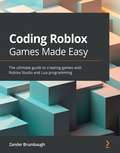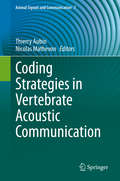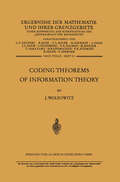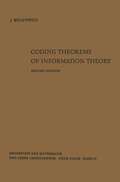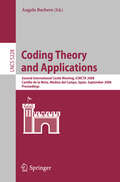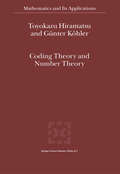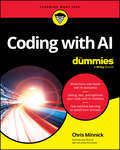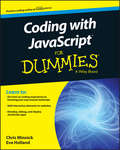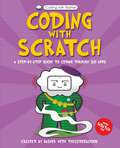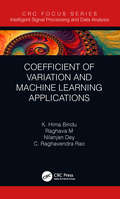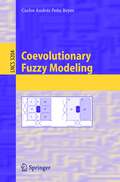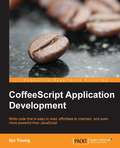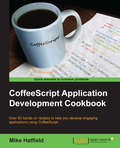- Table View
- List View
Coding Ockham's Razor
by Lloyd AllisonThis book explores inductive inference using the minimum message length (MML) principle, a Bayesian method which is a realisation of Ockham's Razor based on information theory. Accompanied by a library of software, the book can assist an applications programmer, student or researcher in the fields of data analysis and machine learning to write computer programs based upon this principle. MML inference has been around for 50 years and yet only one highly technical book has been written about the subject. The majority of research in the field has been backed by specialised one-off programs but this book includes a library of general MML–based software, in Java. The Java source code is available under the GNU GPL open-source license. The software library is documented using Javadoc which produces extensive cross referenced HTML manual pages. Every probability distribution and statistical model that is described in the book is implemented and documented in the software library. The library may contain a component that directly solves a reader's inference problem, or contain components that can be put together to solve the problem, or provide a standard interface under which a new component can be written to solve the problem. This book will be of interest to application developers in the fields of machine learning and statistics as well as academics, postdocs, programmers and data scientists. It could also be used by third year or fourth year undergraduate or postgraduate students.
Coding Regulation: Essays on the Normative Role of Information Technology (PDF)
by Egbert Dommering Lodewijk Asscher L F Asscher E. J. Dommering J. C. FischerThe collected essays in this book discuss the interaction between law and technology and the normative role of information technology. More precisely, this book focuses on the way information and communication technologies regulate our behaviour. Can information technology be an alternative for legal regulation and, if so, what are the risks? Can technology be used to circumvent constitutional safeguards? Is technology regulation just another form of self-regulation? Is regulation through technology distorting traditional balances of rights? Those are all questions that are discussed from different angles, and with different legal perspectives. The essays also discuss more general issues of legitimacy, and of transparency of the normative role of information technologies. We hope to provide a meaningful contribution to the lively debate on the relationship between law and information technology.
Coding Roblox Games Made Easy: The ultimate guide to creating games with Roblox Studio and Lua programming
by Zander BrumbaughGet up and running with Roblox development with the help of expert guidance for working with Roblox components and Lua programmingKey FeaturesDiscover solutions to common problems faced while creating games on RobloxExplore tips, tricks, and best practices and learn advanced Roblox coding techniques to create gamesUnderstand how to program in the Roblox Lua language, add engaging effects, add a variety of functionalities, and much moreBook DescriptionRoblox is a global virtual platform like no other for both playing and creating games. With well over 150 million monthly active users, Roblox hosts all genres of games that can be played by other members of the community using the Lua programming language. Not only can you create games for free, but you can also earn considerable sums of money if from the success of your games, and become part of the vast and supportive developer circle that provides excellent opportunities for networking in a tight-knit community. With this practical book, you'll get hands-on experience working on the Roblox platform. You'll start with an overview of Roblox development and then understand how to use Roblox Studio. As you progress, you'll gradually learn everything you need from how to program in Roblox Lua to creating Obby and Battle Royale games. Finally, you'll delve into the logistics of game production, focusing on optimizing the performance of your game by implementing impressive mechanics, monetization, and marketing practices. By the end of this Roblox book, you'll be able to lead or work with a team to bring your gaming world to life, and extend that experience to players around the world.What you will learnGet started with Roblox development and explore aspects such as choosing a developer typeUnderstand how to use Roblox Studio and other free resourcesCreate your first game with the Roblox Lua programming languageBecome well-versed with the three Ms - Mechanics, Monetization, and MarketingDevelop real-world games such as Battle Royale and ObbyDiscover expert tips for collaborating effectively and managing project workloadsWho this book is forThis Roblox guide is for anyone interested in learning how to develop games on the Roblox platform. If you're already familiar with Roblox and looking for tips, tricks, and Roblox and Lua best practices for efficient development, you'll find this book helpful.
Coding Strategies in Vertebrate Acoustic Communication (Animal Signals and Communication #7)
by Thierry Aubin Nicolas MathevonInformation is a core concept in animal communication: individuals routinely produce, acquire, process and store information, which provides the basis for their social life. This book focuses on how animal acoustic signals code information and how this coding can be shaped by various environmental and social constraints. Taking birds and mammals, including humans, as models, the authors explore such topics as communication strategies for “public” and “private” signaling, static and dynamic signaling, the diversity of coded information and the way information is decoded by the receiver. The book appeals to a wide audience, ranging from bioacousticians, ethologists and ecologists to evolutionary biologists. Intended for students and researchers alike, it promotes the idea that Shannon and Weaver’s Mathematical Theory of Communication still represents a strong framework for understanding all aspects of the communication process, including its dynamic dimensions.
Coding the Arduino: Building Fun Programs, Games, and Electronic Projects
by Bob DukishGet started with Arduino and computer coding. This book is intended for those new to the Arduino and computer coding. and looking to gain the skills to write microcontroller programs that can act on given inputs and operate electromechanical output devices. Coding the Arduino contains four sections: background information, game development, electronic games and projects, and expanded programs. The final chapters expand on the functionality of some of the programs presented in previous chapters, and challenges you with capstone projects. The projects will be described where the program code that is presented can be modified, or in which two or more of the sample programs may be used to synthesize a new program as the solution to the problem that is presented. Additionally, review questions are presented at the end of each chapter to test your comprehension of the material. What You'll LearnUnderstand basic principles of technology, and about analog and digital electronics.Create games from scratch, where you interactively play against the program.Gain an introduction to Artificial Intelligence (AI)Who This Book Is ForElectronic hobbyists, makers of all levels, and teens with an interest in technology and coding who are looking to get started with Arduinos.
Coding Theorems of Information Theory (Ergebnisse der Mathematik und ihrer Grenzgebiete. 2. Folge #31)
by J. WolfowitzThe objective of the present edition of this monograph is the same as that of earlier editions, namely, to provide readers with some mathemati cal maturity a rigorous and modern introduction to the ideas and principal theorems of probabilistic information theory. It is not necessary that readers have any prior knowledge whatever of information theory. The rapid development of the subject has had the consequence that any one book can now cover only a fraction of the literature. The latter is often written by engineers for engineers, and the mathematical reader may have some difficulty with it. The mathematician who understands the content and methods of this monograph should be able to read the literature and start on research of his own in a subject of mathematical beauty and interest. The present edition differs from the second in the following: Chapter 6 has been completely replaced by one on arbitrarily varying channels. Chapter 7 has been greatly enlarged. Chapter 8 on semi-continuous channels has been drastically shortened, and Chapter 11 on sequential decoding completely removed. The new Chapters 11-15 consist entirely of material which has been developed only in the last few years. The topics discussed are rate distortion, source coding, multiple access channels, and degraded broadcast channels. Even the specialist will find a new approach in the treatment of these subjects. Many of the proofs are new, more perspicuous, and considerably shorter than the original ones.
Coding Theorems of Information Theory: Reihe: Wahrscheinlichkeitstheorie und Mathematische Statistik (Ergebnisse der Mathematik und ihrer Grenzgebiete. 2. Folge #31)
by Jacob WolfowitzThis monograph originated with a course of lectures on information theory which I gave at Cornell University during the academic year 1958-1959. It has no pretensions to exhaustiveness, and, indeed, no pretensions at all. Its purpose is to provide, for mathematicians of some maturity, an easy introduction to the ideas and principal known theorems of a certain body of coding theory. This purpose will be amply achieved if the reader is enabled, through his reading, to read the (sometimes obscurely written) literature and to obtain results of his own. The theory is ob viously in a rapid stage of development; even while this monograph was in manuscript several of its readers obtained important new results. The first chapter is introductory and the subject matter of the monograph is described at the end of the chapter. There does not seem to be a uniquely determined logical order in which the material should be arranged. In determining the final arrangement I tried to obtain an order which makes reading easy and yet is not illogical. I can only hope that the resultant compromises do not earn me the criticism that I failed on both counts. There are a very few instances in the monograph where a stated theorem is proved by a method which is based on a result proved only later.
Coding Theorems of Information Theory (Ergebnisse der Mathematik und ihrer Grenzgebiete. 2. Folge #31)
by Jacob WolfowitzThe imminent exhaustion of the first printing of this monograph and the kind willingness of the publishers have presented me with the opportunity to correct a few minor misprints and to make a number of additions to the first edition. Some of these additions are in the form of remarks scattered throughout the monograph. The principal additions are Chapter 11, most of Section 6. 6 (inc1uding Theorem 6. 6. 2), Sections 6. 7, 7. 7, and 4. 9. It has been impossible to inc1ude all the novel and inter esting results which have appeared in the last three years. I hope to inc1ude these in a new edition or a new monograph, to be written in a few years when the main new currents of research are more clearly visible. There are now several instances where, in the first edition, only a weak converse was proved, and, in the present edition, the proof of a strong converse is given. Where the proof of the weaker theorem em ploys a method of general application and interest it has been retained and is given along with the proof of the stronger result. This is wholly in accord with the purpose of the present monograph, which is not only to prove the principal coding theorems but also, while doing so, to acquaint the reader with the most fruitful and interesting ideas and methods used in the theory. I am indebted to Dr.
Coding Theory and Applications: 5th International Castle Meeting, ICMCTA 2017, Vihula, Estonia, August 28-31, 2017, Proceedings (Lecture Notes in Computer Science #10495)
by Ángela I. Barbero, Vitaly Skachek and Øyvind YtrehusThis book constitutes the refereed proceedings of the 5th International Castle Meeting on Coding Theory and Applications, ICMCTA 2017, held in Vihula, Estonia, in August 2017.The 24 full papers presented were carefully reviewed and selected for inclusion in this volume. The papers cover relevant research areas in modern coding theory, including codes and combinatorial structures, algebraic geometric codes, group codes, convolutional codes, network coding, other applications to communications, and applications of coding theory in cryptography.
Coding Theory and Applications: 2nd International Castle Meeting, ISMCTA 2008, Castillo de la Mota, Medina del Campo, Spain, September 15-19, 2008, Proceedings (Lecture Notes in Computer Science #5228)
by Angela BarberoIt is a pleasure to welcome you to the proceedings of the second International Castle Meeting on Coding Theory and its Applications, held at La Mota Castle in Medina del Campo. The event provided a forum for the exchange of results and ideas, which we hope will foster future collaboration. The ?rst meeting was held in 1999, and, encouraged by that experience, we now intend to hold the meeting every three years. Springer kindly accepted to publish the proceedings volume you have in your hands in their LNCS series. The topics were selected to cover some of the areas of research in Coding Theory that are currently receiving the most attention. The program consisted of a mixture of invited and submitted talks, with the focus on quality rather than quantity. A total of 34 papers were submitted to themeeting.Afteracarefulreviewprocessconductedbythescienti?ccommittee aided by external reviewers, we selected 14 of these for inclusion in the current volume, along with 5 invited papers. The program was further augmented by the remaining invited papers in addition to papers on recent results, printed in a separate volume. We would like to thank everyone who made this meeting possible by helping with the practical and scienti?c preparations: the organization committee, the scienti?c committee, the invited speakers, and the many external reviewers who shall remain anonymous. I would especially like to mention the General Advisor ofthe meeting, ØyvindYtrehus.Finally Iextend mygratitudeto allthe authors and participants who contributed to this meeting.
Coding Theory and Applications: 4th International Castle Meeting, Palmela Castle, Portugal, September 15-18, 2014 (CIM Series in Mathematical Sciences #3)
by Raquel Pinto Paula Rocha Malonek Paolo VettoriThe topics covered in this book, written by researchers at the forefront of their field, represent some of the most relevant research areas in modern coding theory: codes and combinatorial structures, algebraic geometric codes, group codes, quantum codes, convolutional codes, network coding and cryptography.The book includes a survey paper on the interconnections of coding theory with constrained systems, written by an invited speaker, as well as 37 cutting-edge research communications presented at the 4th International Castle Meeting on Coding Theory and Applications (4ICMCTA), held at the Castle of Palmela in September 2014. The event’s scientific program consisted of four invited talks and 39 regular talks by authors from 24 different countries. This conference provided an ideal opportunity for communicating new results, exchanging ideas, strengthening international cooperation, and introducing young researchers into the coding theory community.
Coding Theory and Cryptography: The Essentials, Second Edition (Chapman And Hall/crc Pure And Applied Mathematics Ser.)
by D. C. Hankerson Gary Hoffman D. A. Leonard Charles C. Lindner K. T. Phelps C. A. Rodger J. R. WallContaining data on number theory, encryption schemes, and cyclic codes, this highly successful textbook, proven by the authors in a popular two-quarter course, presents coding theory, construction, encoding, and decoding of specific code families in an "easy-to-use" manner appropriate for students with only a basic background in mathematics offerin
Coding Theory and Number Theory (Mathematics and Its Applications #554-A)
by T. Hiramatsu Günter KöhlerThis book grew out of our lectures given in the Oberseminar on 'Cod ing Theory and Number Theory' at the Mathematics Institute of the Wiirzburg University in the Summer Semester, 2001. The coding the ory combines mathematical elegance and some engineering problems to an unusual degree. The major advantage of studying coding theory is the beauty of this particular combination of mathematics and engineering. In this book we wish to introduce some practical problems to the math ematician and to address these as an essential part of the development of modern number theory. The book consists of five chapters and an appendix. Chapter 1 may mostly be dropped from an introductory course of linear codes. In Chap ter 2 we discuss some relations between the number of solutions of a diagonal equation over finite fields and the weight distribution of cyclic codes. Chapter 3 begins by reviewing some basic facts from elliptic curves over finite fields and modular forms, and shows that the weight distribution of the Melas codes is represented by means of the trace of the Hecke operators acting on the space of cusp forms. Chapter 4 is a systematic study of the algebraic-geometric codes. For a long time, the study of algebraic curves over finite fields was the province of pure mathematicians. In the period 1977 - 1982, V. D. Goppa discovered an amazing connection between the theory of algebraic curves over fi nite fields and the theory of q-ary codes.
Coding Theory, Cryptography and Related Areas: Proceedings of an International Conference on Coding Theory, Cryptography and Related Areas, held in Guanajuato, Mexico, in April 1998
by Johannes Buchmann Tom Hoeholdt Henning Stichtenoth Horacio Tapia-RecillasA series of research papers on various aspects of coding theory, cryptography, and other areas, including new and unpublished results on the subjects. The book will be useful to students, researchers, professionals, and tutors interested in this area of research.
Coding with AI For Dummies
by Chris MinnickBoost your coding output and accuracy with artificial intelligence tools Coding with AI For Dummies introduces you to the many ways that artificial intelligence can make your life as a coder easier. Even if you’re brand new to using AI, this book will show you around the new tools that can produce, examine, and fix code for you. With AI, you can automate processes like code documentation, debugging, updating, and optimization. The time saved thanks to AI lets you focus on the core development tasks that make you even more valuable. Learn the secrets behind coding assistant platforms and get step-by-step instructions on how to implement them to make coding a smoother process. Thanks to AI and this Dummies guide, you’ll be coding faster and better in no time. Discover all the core coding tasks boosted by artificial intelligence Meet the top AI coding assistance platforms currently on the market Learn how to generate documentation with AI and use AI to keep your code up to date Use predictive tools to help speed up the coding process and eliminate bugs This is a great Dummies guide for new and experienced programmers alike. Get started with AI coding and expand your programming toolkit with Coding with AI For Dummies.
Coding with AI For Dummies
by Chris MinnickBoost your coding output and accuracy with artificial intelligence tools Coding with AI For Dummies introduces you to the many ways that artificial intelligence can make your life as a coder easier. Even if you’re brand new to using AI, this book will show you around the new tools that can produce, examine, and fix code for you. With AI, you can automate processes like code documentation, debugging, updating, and optimization. The time saved thanks to AI lets you focus on the core development tasks that make you even more valuable. Learn the secrets behind coding assistant platforms and get step-by-step instructions on how to implement them to make coding a smoother process. Thanks to AI and this Dummies guide, you’ll be coding faster and better in no time. Discover all the core coding tasks boosted by artificial intelligence Meet the top AI coding assistance platforms currently on the market Learn how to generate documentation with AI and use AI to keep your code up to date Use predictive tools to help speed up the coding process and eliminate bugs This is a great Dummies guide for new and experienced programmers alike. Get started with AI coding and expand your programming toolkit with Coding with AI For Dummies.
Coding with JavaScript For Dummies
by Chris Minnick Eva HollandGo from beginner to builder quickly with this hands-on JavaScript guide Coding with JavaScript For Dummies provides easy, hands-on instruction for anyone looking to learn this popular client-side language. No experience? No problem! This friendly guide starts from the very beginning and walks you through the basics, then shows you how to apply what you've learned to real projects. You'll start building right away, including web page elements and simple applications, so you can immediately see how JavaScript is used in the real world. Online exercises allow you to test your code and expand your skills, and the easy-to-follow instruction provides step-by-step guidance toward understanding the JavaScript syntax, applications, and language. JavaScript enhances static web pages by providing dynamic elements that can adapt and react to user action. It's a need-to-know tool for aspiring web designers, but anyone can benefit from understanding this core development language. Coding with JavaScript For Dummies takes you from beginner to builder quickly as you: Learn what JavaScript does, how it works, and where to use it Master the core elements of JavaScript and immediately put it to work Build interactive web elements and try out your code online Create basic applications as you apply JavaScript to the app development workflow Anytime a website responds to your movement around the screen, that's JavaScript. It makes websites more functional, more beautiful, and more engaging, and your site visitors will demand nothing less. If you want to build a better website, you need JavaScript. If you need JavaScript, Coding with JavaScript For Dummies gets you started off quickly and painlessly, with plenty of hands-on practice.
Coding with JavaScript For Dummies
by Chris Minnick Eva HollandGo from beginner to builder quickly with this hands-on JavaScript guide Coding with JavaScript For Dummies provides easy, hands-on instruction for anyone looking to learn this popular client-side language. No experience? No problem! This friendly guide starts from the very beginning and walks you through the basics, then shows you how to apply what you've learned to real projects. You'll start building right away, including web page elements and simple applications, so you can immediately see how JavaScript is used in the real world. Online exercises allow you to test your code and expand your skills, and the easy-to-follow instruction provides step-by-step guidance toward understanding the JavaScript syntax, applications, and language. JavaScript enhances static web pages by providing dynamic elements that can adapt and react to user action. It's a need-to-know tool for aspiring web designers, but anyone can benefit from understanding this core development language. Coding with JavaScript For Dummies takes you from beginner to builder quickly as you: Learn what JavaScript does, how it works, and where to use it Master the core elements of JavaScript and immediately put it to work Build interactive web elements and try out your code online Create basic applications as you apply JavaScript to the app development workflow Anytime a website responds to your movement around the screen, that's JavaScript. It makes websites more functional, more beautiful, and more engaging, and your site visitors will demand nothing less. If you want to build a better website, you need JavaScript. If you need JavaScript, Coding with JavaScript For Dummies gets you started off quickly and painlessly, with plenty of hands-on practice.
Coding with Scratch (Coding with Basher)
by The Coder SchoolWritten by the founders of Silicon Valley’s the CoderSchool, Basher’s Coding With Scratch is a really useful step-by-step guide to basic programming that’s packed with quirky, colourful characters – from Variable and If/Then to Loop and Function – who will teach you how to make your very own apps with Scratch 3.0. Young readers will learn all the basics of programming, then put their knowledge to the test in a series of apps, before building their first actual computer game. Plus there are lots of fun challenges to try along the way!Combining Basher's trademark quirky and humorous illustration style with the very latest teachings on coding, Coding With Scratch is the ultimate step-by-step guide to mastering Scratch.
Coefficient of Variation and Machine Learning Applications (Intelligent Signal Processing and Data Analysis)
by K. Hima Bindu Raghava Morusupalli Nilanjan Dey C. Raghavendra RaoCoefficient of Variation (CV) is a unit free index indicating the consistency of the data associated with a real-world process and is simple to mold into computational paradigms. This book provides necessary exposure of computational strategies, properties of CV and extracting the metadata leading to efficient knowledge representation. It also compiles representational and classification strategies based on the CV through illustrative explanations. The potential nature of CV in the context of contemporary Machine Learning strategies and the Big Data paradigms is demonstrated through selected applications. Overall, this book explains statistical parameters and knowledge representation models.
Coefficient of Variation and Machine Learning Applications (Intelligent Signal Processing and Data Analysis)
by K. Hima Bindu Raghava Morusupalli Nilanjan Dey C. Raghavendra RaoCoefficient of Variation (CV) is a unit free index indicating the consistency of the data associated with a real-world process and is simple to mold into computational paradigms. This book provides necessary exposure of computational strategies, properties of CV and extracting the metadata leading to efficient knowledge representation. It also compiles representational and classification strategies based on the CV through illustrative explanations. The potential nature of CV in the context of contemporary Machine Learning strategies and the Big Data paradigms is demonstrated through selected applications. Overall, this book explains statistical parameters and knowledge representation models.
Coevolutionary Fuzzy Modeling (Lecture Notes in Computer Science #3204)
by Carlos Andrés Peña-ReyesBuilding on fuzzy logic and evolutionary computing, this book introduces fuzzy cooperative coevolution as a novel approach to systems design, conductive to explaining human decision process. Fuzzy cooperative coevolution is a methodology for constructing systems able to accurately predict the outcome of a decision-making process, while providing an understandable explanation of the underlying reasoning. The central contribution of this work is the use of an advanced evolutionary technique, cooperative coevolution, for dealing with the simultaneous design of connective and operational parameters. Cooperative coevolution overcomes several limitations exhibited by other standard evolutionary approaches. The applicability of fuzzy cooperative coevolution is validated by modeling the decision processes of three real-world problems, an iris data benchmark problem and two problems from breast cancer diagnosis.
CoffeeScript Application Development
by Ian YoungCoffeeScript Application Development is a practical, hands-on guide with step-by-step instructions. Follow the smooth and easy tutorial approach, covering examples that build in complexity. By the final chapter you'll be wondering why you didn't try CoffeeScript sooner. If you are a JavaScript developer who wants to save time and add power to your code, then this is the book that will help you do it. With minimal fuss you will learn a whole new language which will reduce your application development time from weeks to days.
CoffeeScript Application Development Cookbook
by Mike HatfieldIf you are interested in developing modern applications, this book will help you leverage the vast JavaScript ecosystem while using an elegant language, helping you avoid the shortcomings of JavaScript.


